What is the principle of using a food heater?

1、 Microwave heater
Principle:
Microwave heaters use the energy of microwaves to heat water molecules in food, thereby making the food warmer. This type of device typically consists of a microwave generator, microwave tube, and heating chamber. The microwave generator generates microwaves, and the microwave tube guides the microwaves into the heating chamber.
When food is placed in a heating chamber, microwaves interact with water molecules in the food, causing them to vibrate and generate heat, thereby making the food warmer. The advantage of microwave heating is that it can evenly heat food, with short heating time and high efficiency.
characteristic:
Microwave heating is achieved by the high-frequency reciprocating motion of dipole molecules inside the heated object, generating "internal frictional heat" to increase the temperature of the heated material. It does not require any thermal conduction process and can simultaneously heat and raise the temperature inside and outside the material.
The inertia of microwave heating is very small, which can achieve rapid control of temperature rise and fall, and is conducive to automatic control of continuous production.
Microwave heating has the characteristic of selective heating, that is, substances with different dielectric constants have different absorption abilities for microwaves, so the heating effect will also vary.

2、 Electromagnetic heater
Principle:
Electromagnetic heaters use eddy currents and hysteresis losses generated by alternating electromagnetic fields to heat objects. When the heating element is placed in an alternating electromagnetic field, eddy currents and hysteresis losses are generated inside the heating element, which convert energy into thermal energy and increase the temperature of the heating element.
characteristic:
Electromagnetic heating can directly convert electrical energy into thermal energy, with high heating efficiency.
No open flames are generated during the heating process, ensuring high safety.
3、 Resistance heater (such as rice cooker)
Principle:
Resistance heaters are usually made of resistive materials, and when current passes through a resistor, heat is generated due to the hindering effect of the resistor. This heat energy is used to heat food to the appropriate temperature.
characteristic:
Electric rice cookers and other resistance heaters usually have temperature control functions, detecting the temperature inside the pot through components such as thermistors, and adjusting the power of the heater based on temperature information to maintain the temperature within the set range.
The heating process is stable and reliable, suitable for various food heating scenarios that require precise temperature control.
In summary, there are various principles for using food heaters, including microwave heating, electromagnetic heating, and resistance heating. Different types of heaters have different working principles and characteristics, suitable for different heating needs and scenarios.
